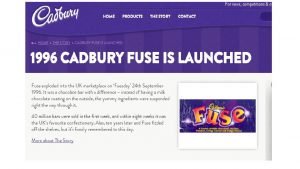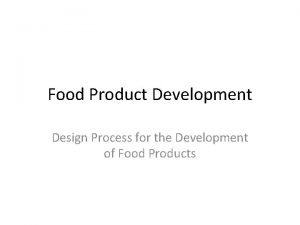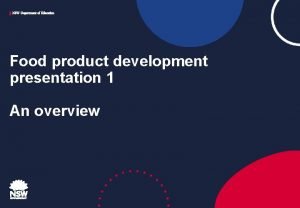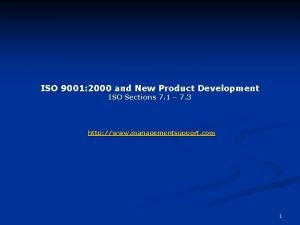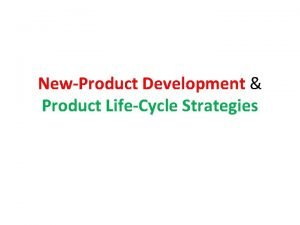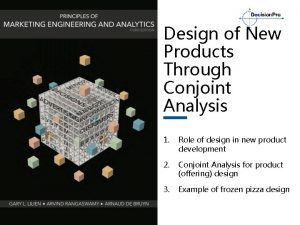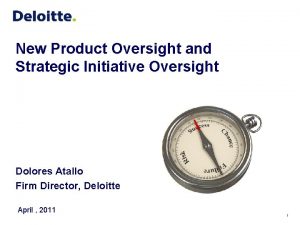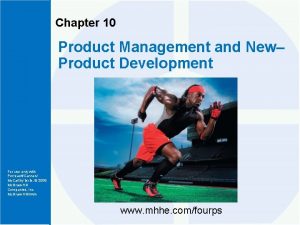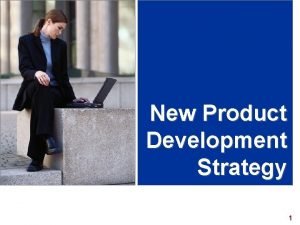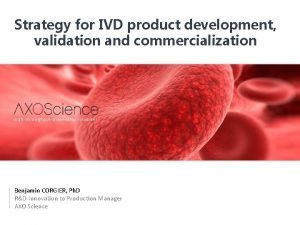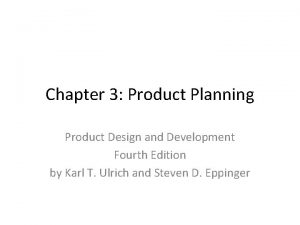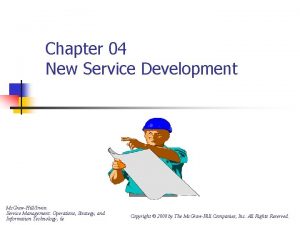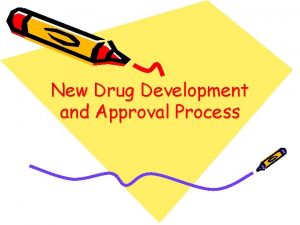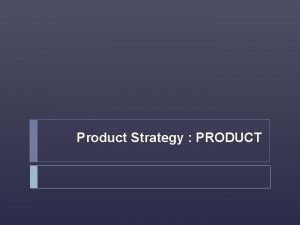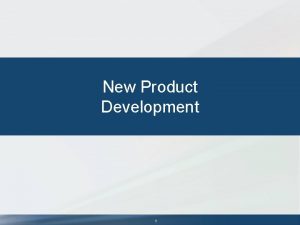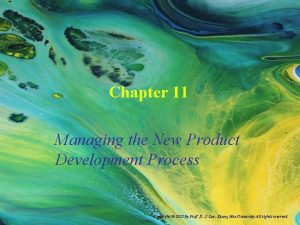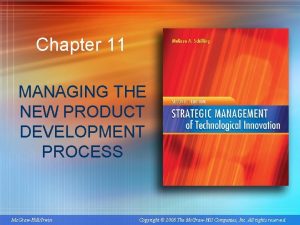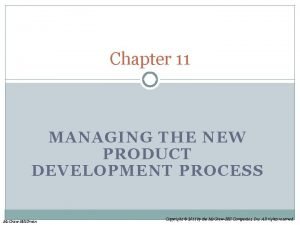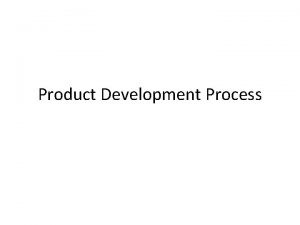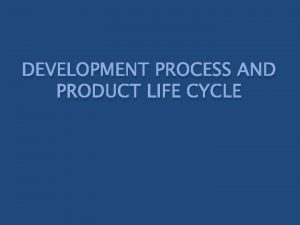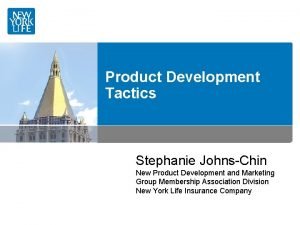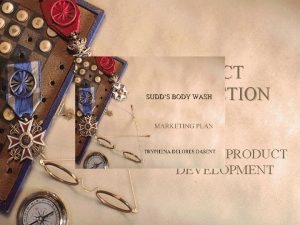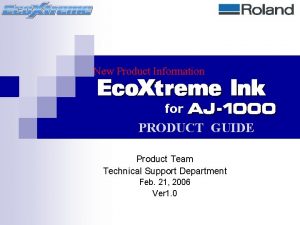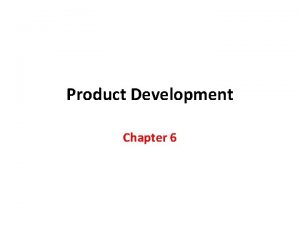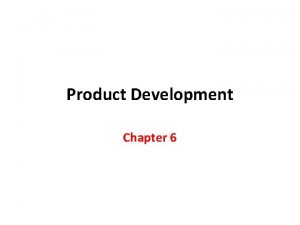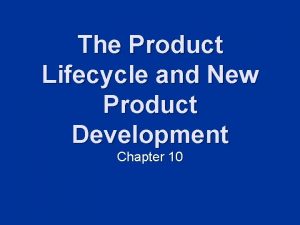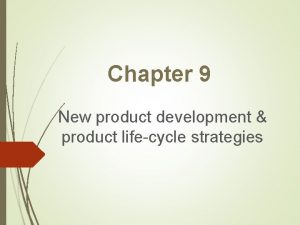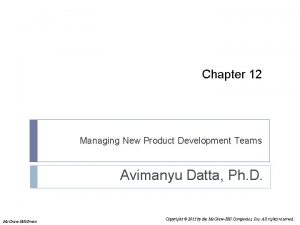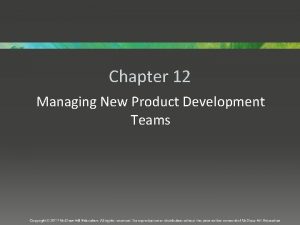Chapter 11 Managing the New Product Development Process
























- Slides: 24

Chapter 11 Managing the New Product Development Process

Overview § Despite the intense attention paid to innovation, failure rates are still very high. § More than 95% of new product development projects fail to earn an economic return. § This chapter summarizes research on how to make new product development more effective and efficient. 11 -2

Sequential versus Party Parallel Development Processes § Before mid-1990 s, most US companies used sequential NPD process; now many use partly parallel process. § Partly parallel process shortens overall development time, and enables closer coordination between stages. § In some situations, however, a parallel development process can increase risks. 11 -3

Project Champions § 68% of North American firms, 58% of European firms, and 48% of Japanese firms report using senior executives to champion their NPD projects. § Benefits of Championing § Senior execs have power to fight for project § They can gain access to resources § They can communicate with multiple areas of firm § Risks of Championing § Role as champion may cloud judgment about project § May suffer from escalating commitment § Others may fear challenging senior executive § May benefit firm to develop “antichampions” and encourage expression of dissenting opinion. 11 -4

Theory In Action The Development of Zantac § In the 1970 s, David Jack of Glaxo Holdings began working on an ulcer drug. Unfortunately, Smith. Kline Beecham beat Glaxo to market, introducing Tagamet in 1977. § Jack decided to introduce an improved product, and implemented the first parallel process in pharmaceuticals to beat Merck and Eli Lilly to market. The compressed development process would shorten development time, but was also expensive and risky. § Fortunately, Paul Girolami, Glaxo’s director of finance, chose to champion the project, and encouraged Jack to develop improvements to the product which would differentiate it. § By 1987, Glaxo’s Zantac was outselling Tagamet. Jack and Girolami were knighted, and Girolami became Glaxo’s chairman. 11 -5

Research Brief Five Myths About Product Champions § Markham and Aiman-Smith argue that a number of myths have become widely accepted about champions. § Myth 1: Projects with champions are more likely to be successful in the market (many factors determining market success are typically beyond champion’s control) § Myth 2: Champions get involved because they are excited about project rather than from self-interest (results suggest that champions more likely to support projects that benefit their own departments) § Myth 3: Champions are more likely to be involved with radical innovation projects (equally likely to be involved with incremental projects) § Myth 4: Champions are more likely to be from high (low) levels in firm (either is equally likely) § Myth 5: Champions are more likely to be from marketing (15% from R&D, 14% from marketing, rest were from other functions or were users) 11 -6

Involving Customers and Suppliers in the Development Process § Involving Customers § Customer is often best able to identify the maximum performance capabilities and minimum service requirements of new product. § Customers may be involved on NPD team. § Firms may also use beta testing to get customer input early in the development process. § Some studies suggest that it is more valuable to use “lead users” than a random sample of customers. § Lead users: Customers who face the same general needs of marketplace but experience them earlier than rest of market and benefit disproportionately from solutions. § Firms reported using lead user method for 38% of the projects they undertook, on average. § Crowdsourcing § Firms can also open up an innovation task to the public through crowdsourcing, where people voluntarily contribute their ideas or effort. Platforms such as Inno. Centive, Yet 2. com, and Top. Coder are well-known crowdsourcing sites. 11 -7

Research Brief The Lead User Method of Product Concept Development § Hilti AG used the lead user method to develop a new pipe hanger. § First customers with lead user characteristics were identified through phone interviews. § Lead users participated in a three-day product concept generation workshop. At end of workshop, a single design was selected as best. § Hilti then presented this design to 12 long-term customers; 10 of the 12 preferred the new design and 9 of the 10 were willing to pay a 20% price premium for it. § The lead user method reduced the cost and time of the project by almost half. 11 -8

Involving Customers and Suppliers in the Development Process § Involving Suppliers § Involving suppliers on NPD team or consulting as an alliance partner can improve product design and development efficiency. § Suppliers can suggest alternative inputs that reduce cost or improve functionality. 11 -9

Tools for Improving the New Product Development Process § Stage-Gate Processes Utilize tough go/kill decision points in the development process help filter out bad projects. 11 -10

Tools for Improving the New Product Development Process § The time and cost of projects escalates with each stage, thus stage-gate processes only permit a project to proceed if all assessments indicate success. 11 -11

Tools for Improving the New Product Development Process § The stage-gate process can be modified to better fit a firm’s particular development needs. § E. g. , Exxon Research and Engineering’s stage-gate system § Nearly 60% of firms use some type of stage-gate process to manage their NPD process. 11 -12

Quality Function Deployment (QFD) – The House of Quality § QFD improves communication and coordination between engineering, marketing, and manufacturing. 11 -13

Quality Function Deployment (QFD) – The House of Quality § Steps for QFD 1. Team identifies customer requirements. 2. Team weights requirements in terms of relative importance. 3. Team identifies engineering attributes that drive performance. 4. Team enters correlations between different engineering attributes. 5. Team indicates relationship between engineering attributes and customer requirements. 6. Team multiplies customer importance rating by relationship to engineering attribute and then sums for each attribute. 7. Team evaluates competition. 8. Using relative importance ratings for engineering attributes and scores for competing products, team determines design targets. 9. Team evaluates the new design based on the design targets. 11 -14

Design for Manufacturing § Design for Manufacturing often involves a set of design rules that reduce cost and development time, while boosting quality. 11 -15

Failure Modes and Effects Analysis § FMEA is a method by which firms identify potential failures in a system, classify them according to their severity, and create a plan to prevent them. § Potential failure modes are evaluated on three criteria of risk: severity, likelihood, and inability of controls to detect the failure. § Each criteria is given a score (1 -lowest, 5 -highest) § Composite score is used to prioritize development efforts 11 -16

Computer-Aided Design/ Computer-Aided Manufacturing § Computer-Aided Design (CAD) is the use of computers to build and test designs. § Enables rapid and inexpensive prototyping. § Computer-Aided Manufacturing (CAM) is the use of machine-controlled processes in manufacturing. § Increases flexibility by enabling faster changes in production set ups. More product variations can be offered at a reasonable cost. § Three-dimensional printing is where a design is printed by laying down thin horizontal strips of material until the model is complete 11 -17

Theory In Action Computer-Aided Design of an America’s Cup Yacht § Normally designing America’s Cup yachts required several months to develop smaller-scale models at a cost of $50, 000 per prototype. § Using computer-aided design, Team New Zealand was able to consider many design specifications in a matter of hours at little cost, enabling more insight into design trade-offs. § Computer-aided design also avoided inaccurate results from using scaled-down prototypes. 11 -18

Tools for Measuring New Product Development Performance § Measuring performance of NPD process can help company improve its innovation strategy and process. § Measures of NPD performance can help management: § identify which projects met their goals and why, § benchmark the organization’s performance compared to that of competitors, or to the organization’s own prior performance, § improve resource allocation and employee compensation, and § refine future innovation strategies § Important to use multiple measures to provide fair representation 11 -19

Tools for Measuring New Product Development Performance § New Product Development Process Metrics include: 1. What was the average cycle time (time-to-market) for development projects? How did this cycle time vary for projects characterized as breakthrough, platform, or derivative projects? 2. What percentage of development projects undertaken within the last five years met all or most of the deadlines set for the project? 3. What percentage of development projects undertaken within the last five years stayed within budget? 4. What percentage of development projects undertaken within the last five years resulted in a completed product? 11 -20

Tools for Measuring New Product Development Performance § Overall Innovation Performance measures include: 1. What is the firm’s return on innovation? (This measure assesses the ratio of the firm’s total profits from new products to its total expeditures, including research and development costs, the costs of retooling and staffing production facilities, and initial commercialization and marketing costs. ) 2. What is the percentage of projects that achieve their sales goals? 3. What percentage of revenues are generated by products developed within the last five years? 4. What is the firm’s ratio of successful projects to its total project portfolio? 11 -21

Theory In Action Postmortems at Microsoft § At Microsoft, almost all projects receive postmortems reports. Team will spend 3 -6 months creating report Report will be anywhere from <10 pgs to >100 pgs. Tend to be extremely candid and can be quite critical. “The purpose of the document is to beat yourself up. ” Report describes team and development activities, product size, product quality, and evaluation of what worked well, what didn’t work well, and what group should improve. § Distributed to team and senior management. § § § 11 -22

Skullcandy § Rick Alden, who had an extensive background in the snowboarding industry, created headphones that would connect to both an audio player and a phone, and had an extreme sports aesthetic. § For many projects, Skullcandy would partner with a celebrity that had a particular style and following (e. g. , Mix Master Mike) who would lend insight into important design features. All steps of the project were scheduled using a Gantt chart. § Skullcandy’s Director of Industrial Design would turn the features into engineering specifications, and an external industrial design company would create photorealistic drawings. The Product Manager would then communicate directly to a factory in China where the headphones would be manufactured. § The Chinese manufacturer used sterolithography to make a wax resin prototype which were brought to tradeshows and vendors to get feedback. Once the refinements were done, “tooling” (the making of molds to mass produce the headphones) began. After that, “it’s just like making doughnuts. ” § Skullcandy used small teams and heavy face-to-face contact. Most people served on multiple teams simultaneously. 11 -23

Skullcandy Discussion Questions: 1. How does Skullcandy's new product development activities affect its ability to (a) maximize the fit with customer needs, (b) minimize development cycle time, and (c) control development costs? 2. What are some of the ways that Skullcandy’s size and growth rate influence its development process? 3. What are the advantages of using Computer Aided Design (CAD) and stereolithography to create prototypes of Skullcandy's headphones? 4. If you were advising the top management of Skullcandy about new product development processes, what recommendations would you make? 11 -24
 New product development and product life cycle strategies
New product development and product life cycle strategies Product development idea generation
Product development idea generation What is specification
What is specification Product planning and development
Product planning and development Product planning and development
Product planning and development Product development funnel
Product development funnel Wbs for new product launch
Wbs for new product launch Food product development definition
Food product development definition New product development procedure iso
New product development procedure iso Objectives of edlc
Objectives of edlc New product planning and development
New product planning and development What is strategic management
What is strategic management Al pacino conjoint
Al pacino conjoint When you apply the ipde process
When you apply the ipde process Use the ipde process chapter 5
Use the ipde process chapter 5 Explain what is meant by selective use of the ipde process
Explain what is meant by selective use of the ipde process Executing the ipde process primarily involves
Executing the ipde process primarily involves Chapter 4 managing risk with the ipde process
Chapter 4 managing risk with the ipde process New product approval process
New product approval process New product planning process
New product planning process New product introduction process
New product introduction process Ivd product development
Ivd product development Product platform planning
Product platform planning New service development in service marketing
New service development in service marketing New drug development and approval process
New drug development and approval process

